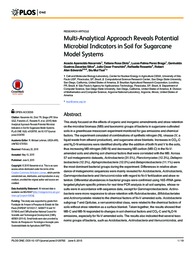Multi-Analytical approach reveals potential microbial indicators in soil for sugarcane model systems.
Multi-Analytical approach reveals potential microbial indicators in soil for sugarcane model systems.
Author(s): NAVARRETE, A. A.; DINIZ, T. R.; BRAGA, L. P. P.; SILVA, G. G. Z.; FRANCHINI, J. C.; ROSSETTO, R.; EDWARDS, R. A.; TSAI, S. M.
Summary: This study focused on the effects of organic and inorganic amendments and straw retention on the microbial biomass (MB) and taxonomic groups of bacteria in sugarcane-cultivated soils in a greenhouse mesocosm experiment monitored for gas emissions and chemical factors. The experiment consisted of combinations of synthetic nitrogen (N), vinasse (V; a liquid waste from ethanol production), and sugarcane-straw blankets. Increases in CO2-C and N2O-N emissions were identified shortly after the addition of both N and V to the soils, thus increasing MB nitrogen (MB-N) and decreasing MB carbon (MB-C) in the N+V- amended soils and altering soil chemical factors that were correlated with the MB. Across 57 soil metagenomic datasets, Actinobacteria (31.5%), Planctomycetes (12.3%), Deltaproteobacteria (12.3%), Alphaproteobacteria (12.0%) and Betaproteobacteria (11.1%) were the most dominant bacterial groups during the experiment. Differences in relative abun- dance of metagenomic sequences were mainly revealed for Acidobacteria, Actinobacteria, Gammaproteobacteria and Verrucomicrobia with regard to N+V fertilization and straw re- tention. Differential abundances in bacterial groups were confirmed using 16S rRNA gene- targeted phylum-specific primers for real-time PCR analysis in all soil samples, whose re- sults were in accordance with sequence data, except for Gammaproteobacteria. Actino- bacteria were more responsive to straw retention with Rubrobacterales, Bifidobacteriales and Actinomycetales related to the chemical factors of N+V-amended soils. Acidobacteria subgroup 7 and Opitutae, a verrucomicrobial class, were related to the chemical factors of soils without straw retention as a surface blanket. Taken together, the results showed that MB-C and MB-N responded to changes in soil chemical factors and CO2-C and N2O-N emissions, especially for N+V-amended soils. The results also indicated that several taxo- nomic groups of bacteria, such as Acidobacteria, Actinobacteria and Verrucomicrobia, and Competing Interests: The authors have declared that no competing interests exist. their subgroups acted as early-warning indicators of N+V amendments and straw retention in sugarcane-cultivated soils, which can alter the soil chemical factors.
Publication year: 2015
Types of publication: Journal article
Unit: Embrapa Soybean
Keywords: Cana de açúcar, Microbiologia do solo, Soil biology, Sugarcane
Observation
Some of Embrapa's publications are published as ePub files. To read them, use or download one of the following free software options to your computer or mobile device. Android: Google Play Books; IOS: iBooks; Windows and Linux: Calibre.
Access other publications
Access the Agricultural Research Database (BDPA) to consult Embrapa's full library collection and records.
Visit Embrapa Bookstore to purchase books and other publications sold by Embrapa.

